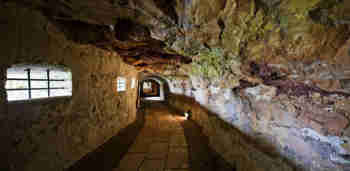The British historical heritage in Menorca
English culture and traditions on the island
All lands hide centuries of historical events, battles and chattels. The isle of Menorca is a destination where culture is marked by the British influence, which has left behind numerous English words still in use, architectural styles ever present, gastronomic recipes, dances and children’s games among many other aspects.

Marlborough Fort
Menorca is also inherited fortifications, constructed by the British to protect the island from the constant attacks by pirates which dominated the Mediterranean during the Modern Era.
On foot, walking, running, hiking, bike riding or on horseback, residents and tourists can use these forms of transport to discover the history of the Menorca past via the ‘British Route and Fortifications of Menorca’ – an itinerary which passes symbolic places which are still conserved to offer an ample vision over the culture and lives on the island centuries ago.
During the XVIII century, Menorca was under the English Crown, and since then the remaining influence continues strong in many aspects of cultural life, such as the beauty spots, architectural styles, gastronomy.
Some houses on the island have conserved balconies as British bow windows, or windows which close upward on weighted rope. Items deep rooted in Menorca, such as gin, distilled in Mahón was established by the British and in cuisine the typical pudding, oxtail soup, pickled capers, have been copied over the years.
Marlborough Fort – Constructed by the British between 1720 and 1726 for the named Duke of Marlborough, John Churchill, an important British general of the time. Its function was to protect the port at Mahón although much was demolished by the Spanish, who rebuilt it years later.
King’s Island - also known as the ‘Bloody Island’ is a small isle located between Mahón and Es Castell which was used by the British forces as a hospital during the XVIII century. Earlier, it is said that King Alfonso II in 1287 named the island.
Kane’s walk – Richard Kane was an Irish solider who governed Menorca between 1712 and 1717. His main contribution was the construction of several roads to facilitate military and agricultural movements between Ciutadella and Saint Philip Castle. The road continues with his name extended past Mahón to Mercadal.
Military Government Headquarters – During the years the King’s House was converted by the British into the Governor’s Palace. The interior still conserves the main characteristics: a ground floor porch below a running gallery on the first floor which gave access to all the rooms. It is still used as the headquarters of the Military Government in Menorca.
An island well protected during centuries of war
Menorca became from its geographical location a clear target from the continued pirate attacks from the Mediterranean during the Modern Era. Rural property owners started to construct towers to protect the population. Years later, during XVI century, Menorca was the battlefield between the Spanish Empire and the Ottoman, which led to more defensive structures such as watchtowers to monitor the seas. During the time of British domination, a large number of fortifications were constructed to gain protection from the enemy.
Battlements –Governor’s Bastian
Constructed in Ciudadela in the XIV century to protect the Islamic medina. In XVI century it had become dilapidated after a Turkish raid on its assets, and during the XVII century a new wall was adapted to the needs of the time. Currently conserved are two Bastian, Sa Font and Governor.
Quart Tower
Supposes a strange construction on the island, giving its not linked to the coast. Used as a defence deposit in one of the most vulnerable areas for pirate attacks.
Princess Tower
Located on the cliffs of La Mola, was built to stop enemies from disembarking at Es Freus. Initially, it was used to store gunpowder and animals on the ground floor, the middle floor was the garrison, and on the terrace there was a canon to defend the access. Now it is a free entry museum after suffering a lightning strike.
Lazareto
Was constructed in the XVIII century as a health space for patients suffering the bubonic plague from the Orient and North Africa. Patients were kept in quarantine here. Currently declared as Asset of Cultural Interest and hosts international meetings and congresses. It is well worth a visit.
